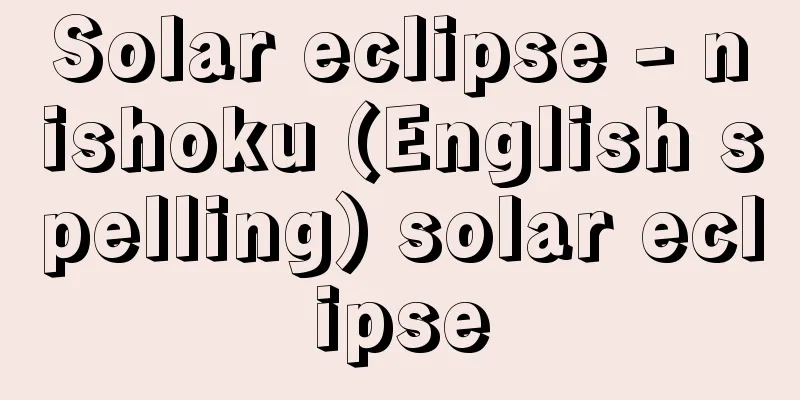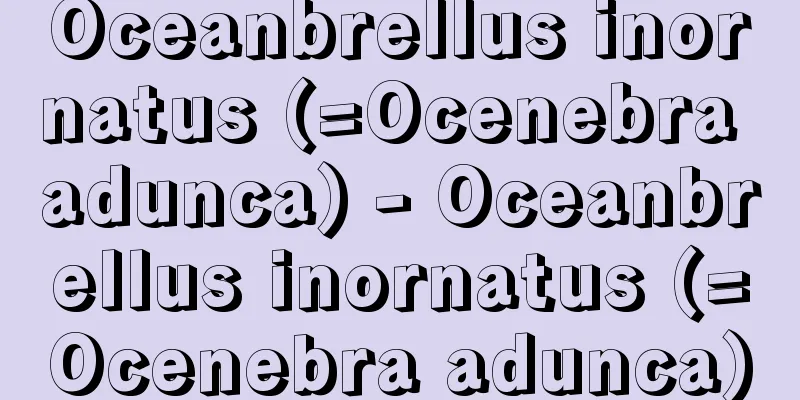Solar eclipse - nishoku (English spelling) solar eclipse

Principles of a Solar EclipseA solar eclipse is a phenomenon in which the Sun is hidden by the Moon. It is also written as solar eclipse. There are total eclipses, where the Sun is completely hidden, partial eclipses, where only a portion of it is hidden, and annular eclipses, where the Sun projects in a ring shape along the edge of the black Moon. During a solar eclipse, the Sun, Moon, and Earth are almost in a straight line, and the shadow of the Moon cast by the Sun is projected onto the Earth. When the umbra (a shadow where no light from the Sun's disk reaches it) reaches the Earth, it is a total eclipse within the umbra, a partial eclipse in areas of the penumbra (a shadow where some light from the Sun's disk reaches), and an annular eclipse when the umbra does not reach the Earth. The Earth orbits the Sun once a year, and the plane of its orbit is called the ecliptic. Meanwhile, the Moon orbits the Earth once every 29.53 days (a synodic month), and the plane of its orbit is called the polar plane. If we consider a large celestial sphere with the Earth at the center, the Sun as seen from Earth moves along the ecliptic, and the Moon moves along the polar plane. The Sun orbits the ecliptic once in a year, and the Moon orbits the polar plane once in 29.53 days. On the celestial sphere, the ecliptic and the ecliptic are inclined at about 5 degrees and 8 minutes, and when the sun and moon come together near the intersection, a solar eclipse occurs. The apparent size (apparent diameter) of both the sun and the moon is about 0.5 degrees, so even if they are located a little away from the intersection, the sun and moon can overlap and cause a solar eclipse. It takes the sun almost 31 days to pass through this, so to speak, eclipse limit. The moon makes one revolution around the ecliptic in 29.53 days, so if a solar eclipse occurs at the end far from the intersection, it will catch up with the slowly moving sun again and cause a solar eclipse. Therefore, at this eclipse limit, a solar eclipse can occur once or twice, and if it occurs twice, both will be partial. A total eclipse or annular eclipse only occurs when the sun and moon come together near the intersection. The Earth is not at a constant distance from the Sun, being closest in early January (perihelion) and farthest in early July (aphelion). The apparent size (apparent diameter) of the Sun changes accordingly, from 31°28' to 32°32'. The distance between the Moon and the Earth is also not constant, and the apparent diameter of the Moon varies from 29°23' to 33°32'. Thus, the apparent diameter of the Moon can sometimes be larger or smaller than the Sun. If it is larger, a total eclipse occurs in the umbra and a partial eclipse occurs in the penumbra, but if it is smaller, an annular eclipse or partial eclipse occurs. Currently, the Moon is moving away from the Earth at a rate of 3.8 centimeters per year due to the Earth's tidal action (conservation of angular momentum). In the distant future, the Moon will become smaller and total eclipses will no longer be visible. [Hiei Eijiro] forecastIn the past, people would look at the stars in the night sky and the movements of the sun, moon, and planets, and from their periodicity, they would try to deduce the laws governing the movements of celestial bodies, which led to the creation of calendars. Calendar systems regulate social activities and are essential for agriculture and animal husbandry. It is said that during the Xia dynasty in China, a solar eclipse occurred, but an astronomer who failed to predict it incurred the wrath of the emperor and was sentenced to death. Learning about the periodicity of solar eclipses and trying to predict them led to improvements in calendar systems throughout the ages. Around 500 BC, the periodicity of solar eclipses, known today as the Saros cycle, was discovered. This is a cyclical cycle of solar eclipses every 18 years and 11 days. Detailed records of solar eclipses over hundreds of years were useful in discovering this periodicity. During the Han dynasty in China, the 135-month eclipse cycle was known, and solar eclipses were predicted based on this. The theory of the Moon's motion is complicated, as it is affected not only by the gravitational force of the Sun, but also by the gravitational force of the Earth and other planets. However, currently, computers are able to calculate the time of contact during a solar eclipse with an accuracy of 0.1 seconds. Because the Moon's limb is uneven, the calculation is made based on its average sphere, but in reality, in deep valleys visible on the Moon's limb, the time can be delayed by 1 to 2 seconds from the predicted value. The Diamond Ring can be seen in such valleys. Based on the theory of the motion of the moon and the earth used in the current calendar, if we consider the period from 2000 BC to 3000 AD, there were 11,898 solar eclipses during that time, with the following frequencies: partial eclipses 35.3%, annular eclipses 33.2%, total eclipses 26.7%, and annular-total eclipses (the same solar eclipse is annular in some places and total in others) 4.8%, with a total eclipse occurring on average once every 1.6 years. The longest total eclipse lasted for 7 minutes and 29 seconds on July 16, 2186. [Hiei Eijiro] How to observe and photograph a solar eclipseTo observe a solar eclipse, prepare dark sunglasses, binoculars, a watch, a camera, and a recording device. Be sure to use sunglasses or a filter, and do not view the eclipse with the naked eye unless it is a total eclipse. After the first contact (when the western edge of the Sun and the Moon first meet), the Sun is gradually hidden by the Moon. Looking through the sunlight, you can see the image of a partial eclipse of the Sun. As you approach the second contact (when the eastern edge of the Sun and the Moon meet), it becomes chilly and the shadows of objects disappear. About 10 seconds before the total eclipse (when the Sun is completely hidden), a faint wave of light and dark called a shadow band runs across the Earth. This may or may not be visible depending on weather conditions. At this time, you can remove your sunglasses or filters. The sunlight filtering through the valleys in the lunar eclipse of the sickle-shaped edge of the Sun looks like a string of beads. This is called "Bailey's beads." Between the beads, the red chromosphere begins to become visible, and the inner corona also becomes visible. Bright stars also begin to become visible. The dark sky, the change in color from the zenith to the horizon, and the strange twilight-like landscape of the entire horizon are characteristic. When the Sun is completely hidden by the Moon, the corona can be observed with the naked eye. Using binoculars, you can see the red chromosphere, the shape of the prominences, the overall shape of the corona and its streak structure. Immediately after the total eclipse ends, the umbra of the Moon flies eastward at a speed of about Mach 3 to 4. It then gradually gets brighter, filling the Earth with light. When trying to record the corona during a solar eclipse, there are several ways to capture images, including (1) the overall landscape including the corona, (2) the image of the sun from partial eclipse to total eclipse, (3) the entire corona, or (4) a part of the corona. In each case, the exposure time is determined in advance and a photography program is created. The brightness (luminance) of the corona is almost equal to the brightness of the full moon, so the exposure time is set by photographing the full moon. When trying to capture a minute corona, a close-up is required, so the focal length of the lens and the size of the field of view are determined in advance. It is best to take a picture with an exposure time that is 1/16 or 1/4 times less than the value determined for the full moon, and then take a picture with an overexposure of 4 or 16 times, and later process the picture to obtain the corona image by computer. When photographing Bailey's rosary, it is necessary to place a high-density filter (neutral density filter 4 to 5. A filter with a density that makes the brightness of the solar surface about the same as the brightness of the full moon) in front of the lens. The exposure time for this should be approximately twice the appropriate exposure time, after previously taking an image of the solar surface with the same dark filter attached. However, when photographing the corona, do not forget to remove the dark filter. Also, during a partial eclipse, if you point the camera at the sun without a dark filter attached, it will burn out the CCD, so be careful. When taking images with a camera, it is important to use a tripod that is as sturdy as possible. [Hiei Eijiro] The Science of Solar EclipsesThe chemical element helium was named after the Greek word helios (sun) because it was the first element observed during a total solar eclipse in 1868. It was 27 years later that helium was discovered to exist on Earth. According to Einstein's theory of relativity, a strong gravitational field like that of the sun distorts space, and stars passing close to the edge of the sun appear to move 1.75 arcseconds away from their original position. This was verified by Eddington and others in the UK during the total solar eclipse on May 9, 1918. Even now, observations are continued at each total solar eclipse to clarify the physical state of the chromosphere and corona, as well as unsolved problems of coronal heating. [Hiei Eijiro] Ancient recordsSolar eclipses are a major natural disaster and have been recorded in every country. In China, solar eclipses were considered important as a warning from heaven to the country's politics. The solar eclipse described in the Book of Documents is estimated to have occurred about 4,000 years ago. The Babylonians also recorded a solar eclipse in Ugarit (on the eastern Mediterranean coast, present-day Syria) in 1375 BC. On May 28, 585 BC, a total solar eclipse occurred in Asia Minor (present-day Turkey). At the time, the kingdoms of Lydia and Medes were at war, but when it suddenly became dark during the day, it was believed to be the wrath of the gods and a peace agreement was made. In Japan, the Nihon Shoki records a solar eclipse on March 2, 36th year of the reign of Empress Suiko (April 10, 628), and the same solar eclipse was also recorded on the first day of the third month of the second year of the Zhenguan era under Emperor Taizong of the Tang Dynasty. From the theory of the motion of the Sun, Earth, and Moon, it should be possible to know when and where solar eclipses occurred in the past, but when comparing records of solar eclipses left in ancient documents, they do not match. However, it has been found that if we consider that the Earth's rotation speed was faster in the past, it matches up well. It is thought that the Earth's rotation speed was 20,000 seconds faster per year in 700 BC, 10,000 seconds faster in 1 AD, and 2,000 seconds faster in 1000 AD, and it has been found that the slowing of the rotation speed is not uniform, but seems to fluctuate over several hundred years. [Hiei Eijiro] [References] | | | | | | |Photographed in Koto-ku, Tokyo on May 21, 2012 (the photo shows the progression of the solar eclipse from left to right). In Japan, the solar eclipse was visible over a wide area on the Pacific coast from Kyushu to southern Tohoku. In Tokyo, the solar eclipse was observed from 6:19 to 9:02, and the annular solar eclipse (center), in which the sun was visible as a ring, lasted for about five minutes from 7:32 to 7:37. ©Shogakukan Annular Solar Eclipse Source: Shogakukan Encyclopedia Nipponica About Encyclopedia Nipponica Information | Legend |
日食の原理日食は、太陽が月によって隠される現象である。日蝕とも書く。太陽全部が隠される皆既食(皆既日食)、一部分が隠される部分食(部分日食)、太陽が黒い月の縁に沿ってリング状にはみ出す金環食(金環日食)がある。日食のときは、太陽―月―地球がほぼ一直線に並び、太陽による月の影が、地上に投影される。本影(太陽面からの光がまったく届かない影)が地上に達するとき、本影内では皆既食、半影(太陽面からの一部の光が届いている影)の地域では部分食、本影が地球に達しないときには金環食となる。 地球は太陽の周りを1年で1周しているが、その軌道面を黄道面という。一方、月は地球の周りを29.53日(朔望月(さくぼうげつ))で1周していて、その軌道面を白道面という。いま、地球を中心にして大きな天球を考えると、地球から見る太陽は黄道を動き、月は白道を動く。太陽は1年かけて黄道を1周し、月は29.53日かけて白道を1周する。 天球上で黄道と白道とは約5度8分傾いているが、その交点近くに太陽と月が来合わせたときに日食がおこる。太陽も月も、見かけの大きさ(視直径)は約0.5度であるので、交点から少し離れた位置にあっても太陽と月が重なり、日食となりうる。このいわば日食限界を通過するのに、太陽はほぼ31日かかる。月は29.53日で白道を1周するので、交点から遠い端で日食がおきると、ゆっくり動く太陽にふたたび追いついて日食がおきる。したがって、この日食限界では、1回または2回日食がおこることがあり、2回のときには、どちらも部分日食となる。皆既食や金環食は、太陽も月も交点近くに来合わしたときのみである。 地球は太陽から一定の距離にはなく、1月上旬にもっとも近づき(近日点)、7月上旬に(遠日点)もっとも遠ざかる。それにしたがって、太陽の見かけの大きさ(視直径)は、角度の31度28分から32度32分と変わる。月と地球との距離も一定ではなく、月の視直径は角度の29度23分から33度32分と変動する。したがって、月の視直径が太陽よりも大きいときや小さいときがある。大きければ、本影内では皆既食となり、半影の地域では部分食となるが、逆に小さいと、金環食や部分食となる。現在月は地球の潮汐作用の影響(角運動量保存)により、地球から1年に3.8センチメートルずつ遠ざかっている。遠い将来は月が小さくなり、皆既食が見られなくなる。 [日江井榮二郎] 予報昔の人々は、夜空の星々や太陽・月、惑星などの運行を眺めて、その周期性から、天体の運行をつかさどる法則を求める努力し、暦がつくられた。暦法は、社会の活動を整え、農業・牧畜には欠かせないものである。中国の夏王朝のとき日食がおきたが、その予報をしなかった天文官が皇帝の怒りをかい、死罪になったと伝えられている。日食がおきる周期性を知り、その予報を行おうとする努力により、各時代における暦法が改良されていった。 紀元前500年ごろに、今日、サロス周期として知られている日食の周期性が発見された。これは、18年11日の日食の循環周期であるが、このような周期性を見つけるのには、数百年以上にわたる詳しい日食の記録が役だった。中国でも漢の時代には、135か月という食の周期を知るようになり、これにより日食を予報していた。 月は太陽の引力だけではなく、地球や他の惑星の引力の影響も受けるので、その運動理論は複雑である。しかし現在では、コンピュータにより日食時の接触時刻は0.1秒の精度で求められている。月縁には凹凸があるので、それの平均的な球面として計算しているが、実際には、月縁に見える深い谷では予想値から、1~2秒、遅れることがある。ダイヤモンド・リングはこのような谷で見られることになる。 現在の暦に採用されている月と地球の運動理論をもとにして紀元前2000年から紀元3000年の期間を考えると、その間に1万1898回の日食がおこり、その頻度は部分食35.3%、金環食33.2%、皆既食26.7%、金環―皆既食(同じ日食でも場所により金環食であり、別の地域では皆既食となる)4.8%であり、皆既食は平均1.6年に一度おこることになる。最長の皆既食の継続時間は、2186年7月16日の7分29秒となる。 [日江井榮二郎] 日食の観察と撮影方法日食の観察には、濃いサングラス、双眼鏡、時計、カメラ、録音装置を用意する。必ず、サングラスやフィルターなどを使い、皆既中以外は、裸眼で見ないようにする。 第一接触(太陽の西側の縁と月とが最初に接する)後、徐々に太陽が月に隠されていく。木漏れ日を見ると、太陽の一部が欠けた部分食の像が見られる。第二接触(太陽の東側の縁と月とが接する)近くになると肌寒くなり、物の影がなくなってくる。 皆既(太陽が完全に隠される)になる10秒ほど直前にはシャドウ・バンドという淡い濃淡のある波が地上を走る。これは気象条件により見えたり、見えなかったりする。このときには、サングラスやフィルターを外してよい。鎌形(かまがた)に細くなった太陽の縁には、月の谷間から漏れる太陽光が、数珠(じゅず)のように連なって見える。これを「ベイリーの数珠」とよぶ。数珠と数珠との間には、紅色の彩層が見えだし、また、内部コロナが見えてくる。 明るい星も見えだす。空の暗さ、天頂から地平線までの色合いの変化、地平線全体の夕暮れのような異様な風景が特徴的である。そして完全に太陽が月に隠されたときのコロナは裸眼でも観察できる。双眼鏡を使えば、紅色の彩層、プロミネンスの形状、コロナ全体の姿やその筋構造を見ることができる。皆既が終わって、直後に月の本影が、マッハ数約3~4で東の方向に飛んで行く。そしてだんだんと明るくなり、地上に光が満ちてくる。 日食時のコロナ像を記録に残そうとするときには、(1)コロナを含めた全体の風景のようす、(2)部分食から皆既までの太陽像、(3)コロナ全体、(4)コロナの一部、を画像にするなどの方法がある。いずれの場合も露出時間をあらかじめ決めておき、撮影のプログラムをつくっておく。コロナの明るさ(輝度)は、ほぼ満月の明るさに等しいので、満月を撮影して露出時間を設定しておく。微細なコロナを撮ろうとするときには、大写しにしなければならないので、撮影レンズの焦点距離と視野の大きさは、あらかじめ決めておく。満月の撮影で決めた露出時間の値よりも、16分の1や4分の1倍だけ少なめに撮影し、さらに4倍や16倍の露出オーバーでも撮影し、あとでコンピュ―タ処理してコロナ画像を得る方法がよい。ベイリーの数珠を撮影するときには、濃度の濃いフィルター(減光フィルター4~5。太陽面の明るさが満月の明るさ程度になる濃度のフィルター)をレンズの前につけて撮影する必要がある。このときの露出時間は、やはり、同じ濃いフィルターをつけてあらかじめ太陽面の撮影をしておき、その適正露出の約2倍の露出時間で撮影をする。ただし、コロナ撮影のときには、濃いフィルターをはずすのを忘れないようにする。また、部分食のときに、濃いフィルターをつけないで太陽に向けるとCCDを焼いてしまうので注意すること。カメラを使って撮影するときには、三脚はできるだけ頑丈なものを使うことがたいせつである。 [日江井榮二郎] 日食の科学化学元素のヘリウムは、1868年に、皆既食で初めて観測された元素であるため、ギリシア語のhelios(太陽)ということばから名づけられた。地上にもヘリウムが存在することがわかったのは、それよりも27年後だった。また、アインシュタインの相対論によると、太陽のような強い重力場では空間が歪(ゆが)み、太陽の縁近くをよぎる星は、1.75秒角だけ本来の位置から遠ざかって見えることになる。1918年5月9日の皆既食でイギリスのエディントンらがそれを検証した。現在も皆既食のたびに、彩層やコロナの物理的な状態や、コロナ加熱の未解決の問題をあきらかにするために観測が続けられている。 [日江井榮二郎] 古来の記録日食現象は天変の一大事件であり、いずれの国でも記録されてきた。中国では、日食は、国の政治に対する天のいましめとして重要視されていた。『書経』に記述されている日食は、いまから約4000年前と推定されている。 またバビロンには紀元前1375年、ウガリット(地中海東岸、現在のシリア)における日食の記録がある。 紀元前585年5月28日、皆既食が小アジア(現在のトルコ)でおこった。このとき、リディアとメディス両王国が戦争をしていたが、突如として日中に暗くなったため、これは神の怒りと信じられて和議が成立したと記録にある。日本では、『日本書紀』に推古天皇36年3月2日(628年4月10日)の日食のことが記述されていて、同じ日食が唐の太宗の貞観2年3月戌申朔にも記録されている。 太陽、地球、月の運動理論から、過去にさかのぼって、いつ、どこで日食がおこったかがわかるはずであるが、古文書に残された日食の記録と照合しても一致しない。しかし、地球の自転速度が昔は今よりも速かったと考えれば、よく合致することがわかってきた。地球の自転速度は、紀元前700年では1年は現在よりも2万秒も速く、紀元1年では1万秒、紀元1000年では2000秒速かったと考えられ、しかも自転速度の遅れは一様ではなく、数百年でうねりがあるらしいことがわかった。 [日江井榮二郎] [参照項目] | | | | | | |2012年(平成24)5月21日、東京都江東区で撮影(写真左から右へ、日食の進行を示す)。日本では九州から東北南部の太平洋側の広い地域で見られた。東京では6時19分から9時2分に日食が観測され、このうち太陽がリング状に見える金環日食(中央)は7時32分から7時37分の約5分間であった©Shogakukan"> 金環日食 出典 小学館 日本大百科全書(ニッポニカ)日本大百科全書(ニッポニカ)について 情報 | 凡例 |
Recommend
otterhound
...A medium-sized breed, 52-60cm tall and weighin...
International School
... refers to a school established by the governm...
Anjou noir (English spelling)
…Located in the basin of the Loire and its tribut...
Ainsliaea apiculata (English spelling)
…[Hiroji Koyama]. . … *Some of the terminology th...
melancholic
...Western words such as temperament, which means...
Illite - Illite (English spelling)
A type of clay mineral. Its chemical composition ...
Babylonian Exile
When the Kingdom of Judah, an ancient Israelite n...
Gregory, J.
...To eliminate this drawback, a reflecting teles...
The Story of Gargantua and Pantagruel - The Story of Gargantua and Pantagruel (English) Gargantua et Pantagruel
A series of stories by François Rabelais, consisti...
Mount Daimonji
Located in the northeast of the urban area of Ky...
Yamaga clan
A warrior who was active mainly in Kyushu from the...
word search puzzle
…The Yaedasuki is a further complex arrangement o...
Thread
It is made by aligning various fibers in a certai...
Krzymowski, R.
…His “Application of Chemistry to Agriculture and...
Troy
An ancient city in northwest Asia Minor. Also know...









